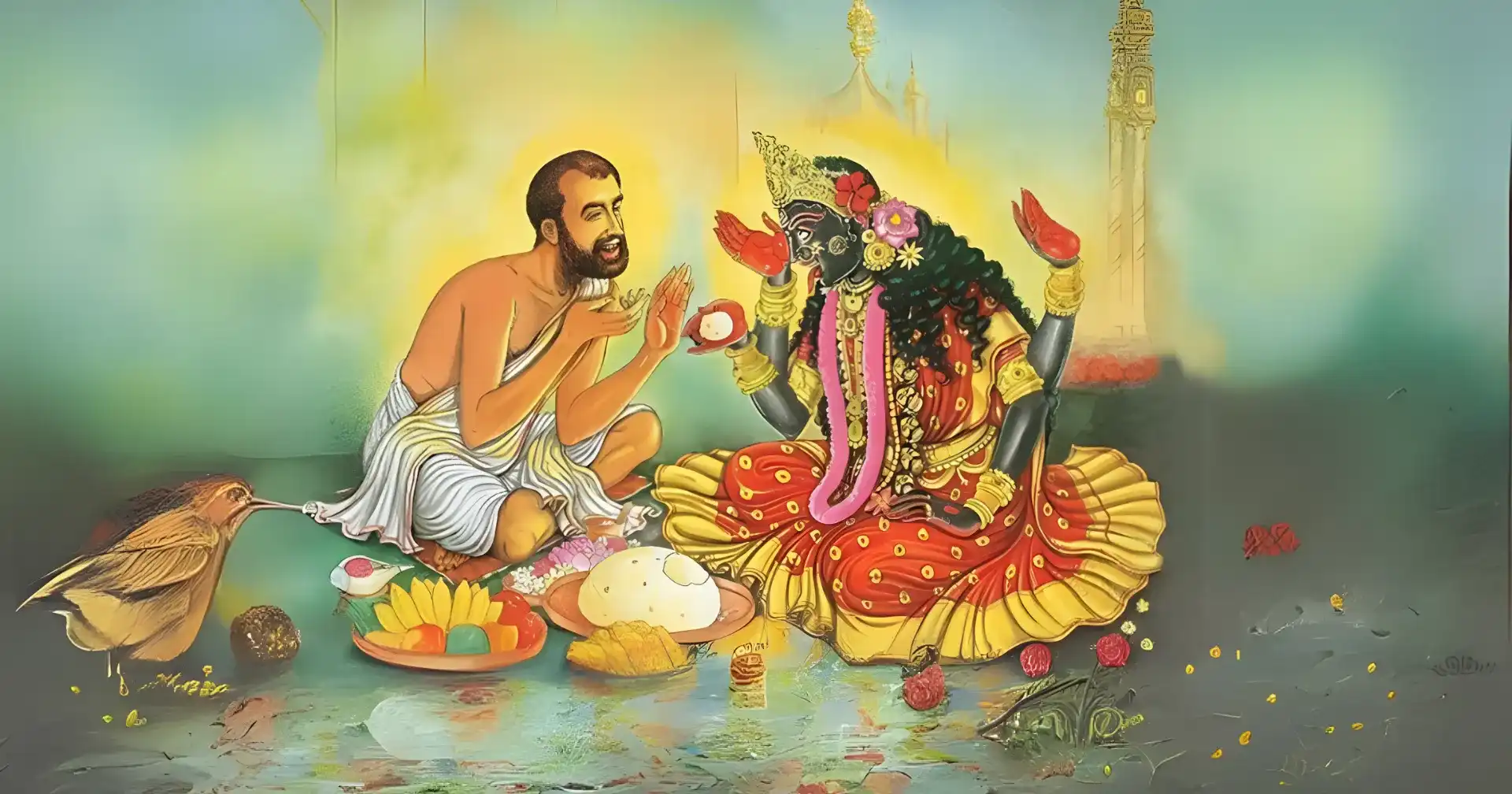Adya Stotram: Here is How it can Transform You
- Protection from illness, enemies, and fear.
- Safety and relief during travel and sea journeys.
- Blessings of wealth, abundance, and security.
- Enhanced maternal health and prevention of miscarriages.
- Divine guidance and favor from deities like Kubera for financial stability.
- Cleansing of Karma and release from worldly attachments.
- Victory in competitions, debates, and conflicts.
- Mental resilience and emotional strength.
- Protection from natural calamities and theft.
- Deep spiritual experience and connection with Goddess Kali.
A Disclaimer
The Adya Stotram (আদ্যা স্তোত্র) relates to Kali Devi Mahavidya. So it is my humble request to Sadhakas to undertake study and practice of this Stotram under a Guru who has Himself established himself under the Grace of Kali Devi.
Many devotees searching for deep inner transformation are guided to the powerful verses of the Adya Stotram. Known also in regional traditions as adya strotram, this sacred hymn isn’t just a prayer, it is a dynamic force. Its recitation has long been believed to cut through karmic cords and awaken the inner Shakti sleeping within us. Whether one seeks spiritual clarity or protection from hidden dangers, the adya strotram acts as a subtle but fierce shield of Devi’s grace.
For your reference Here is Kali maa adya stotram lyrics in english with meaning. The first Stanza (আদ্যা স্তব) is itself a powerful mantra. It is also called the adya maa mantra.
आद्या स्तोत्रम् – ॐ नमः आद्यायै
Adya Stotram – Om Namah Adyayai
Devi Adya Ma | Devi Adya Ma
ॐ नमः आद्यायै ।
Om Namah Aadyaayai
शृणु वत्स प्रवक्ष्यामि आद्या स्तोत्रं महाफलम् ।
यः पठेत् सततं भक्त्या स स्व विष्णुवल्लभः ॥१॥
Shrṇu vatsa pravakṣyāmi ādya stotraṁ mahāphalam |
Yaḥ paṭhet satataṁ bhaktyā sa sva viṣṇuvallabhaḥ ||1||
Meaning:
O dear child, listen. I will now share the sacred Adya Stotram. It gives immense blessings. Whoever chants it regularly with devotion becomes beloved of Lord Vishnu.
मृत्युर्व्याधिभयं तस्य नास्ति किञ्चित् कलौ युगे ।अपुत्रा लभते पुत्रं त्रिपक्षं श्रवणं यदि ॥२॥
Mṛtyur-vyādhi-bhayaṁ tasya nāsti kiñcit kalau yuge |
Aputrā labhate putraṁ tri-pakṣaṁ śravaṇaṁ yadi ||2||
Meaning:
In this dark age (Kali Yuga), chanting this Stotram protects one from fear of death and disease. A childless woman may be blessed with a child if she listens to this for three lunar fortnights.
द्वौ मासौ बन्धनान्मुक्ति विप्रवक्तात् श्रुतं यदि ।मृतवत्सा जीववत्सा षण्मासं श्रवणं यदि ॥३॥
Dvau māsau bandhanān mukti vipra-vaktāt śrutaṁ yadi |
Mṛtavatsā jīvavatsā ṣaṇ-māsaṁ śravaṇaṁ yadi ||3||
Meaning:
If one hears this from a learned sage for two months, they can be freed from all forms of bondage. A woman whose children repeatedly die will bear a surviving child if she listens for six months.
नौकायां सङ्कटे युद्धे पठनाज्जयमाप्नुयात् ।लिखित्वा स्थापयेद्गेहे नाग्निचौरभयं क्कचित् ॥४॥
Naukāyāṁ saṅkaṭe yuddhe paṭhanāj jayam āpnuyāt |
Likhitvā sthāpayet gehe nāgni-caurabhayaṁ k kacit ||4||
Meaning:
Reciting this during times of danger, travel, or battle ensures success. If written and kept in one’s home, it protects from fire and theft.
राजस्थाने जयी नित्यं प्रसन्नाः सर्वदेवता ।ॐ ह्रीं ब्रह्माणी ब्रह्मलोके च वैकुण्ठे सर्वमङ्गला ॥५॥
Rāja-sthāne jayī nityaṁ prasannāḥ sarva-devatāḥ |
Om Hrīṁ Brahmāṇī Brahma-loke ca Vaikuṇṭhe Sarva-maṅgalā ||5||
Meaning:
Where this hymn is recited, all divine forces remain pleased, and one gains victory in royal or political settings. The Goddess exists as Brahmani in Brahma’s world and as Sarvamangala in Vishnu’s world.
इन्द्राणी अमरावत्यामंबिका वरुणालये ।यमालये कालरूपा कुबेरभवने शुभा ॥६॥
Indrāṇī Amarāvatyām Ambikā Varuṇālaye |
Yamālaye Kālarūpā Kuberabhavane Śubhā ||6||
Meaning:
Adya appears as Indrani in heaven, as Ambika in Varuna’s realm, as the fierce Time (Kala) in Yama’s realm, and as the auspicious one in Kubera’s palace.
महानन्दाग्निकोने च वायव्यां मृगवाहिनी ।नैऋत्यां रक्तदन्ता च ऐशाण्यां शूलधारिणी ॥७॥
Mahānandāgnikoṇe ca vāyavyāṁ mṛgavāhinī |
Nairṛtyāṁ raktadantā ca aiśāṇyāṁ śūladhāriṇī ||7||
Meaning:
She rules the southeast as Mahānandā, the northwest as Mṛgavāhinī (deer-rider), the southwest as fierce Raktadantā, and the northeast as Shūladhāriṇī (spear-holder).
पाताले वैष्णवीरूपा सिंहले देवमोहिनी ।सुरसा च मणीद्विपे लङ्कायां भद्रकालिका ॥८॥
Pātāle Vaiṣṇavīrūpā Siṁhale Devamohinī |
Surasā ca Maṇīdvipe Laṅkāyāṁ Bhadrakālikā ||8||
Meaning:
She appears as Vaishnavi in the netherworld, as Devamohini in Sri Lanka, as Surasa in the divine island, and as Bhadrakali in Lanka.
रामेश्वरी सेतुबन्धे विमला पुरुषोत्तमे ।विरजा औड्रदेशे च कामाक्ष्या नीलपर्वते ॥९॥
Rāmeśvarī Setubandhe Vimalā Puruṣottame |
Virajā Auḍradeśe ca Kāmākṣyā Nīlaparvate ||9||
Meaning:
She is Rameshwari in Rameshwaram, Vimala in Puri (Purushottam Kshetra), Viraja in Odisha, and Kamakhya on Nilachal Hill (Assam).
कालिका वङ्गदेशे च अयोध्यायां महेश्वरी ।वाराणस्यामन्नपूर्णा गयाक्षेत्रे गयेश्वरी ॥१०॥
Kālikā Vaṅgadeśe ca Ayodhyāyāṁ Maheśvarī |
Vārāṇasyām Annapūrṇā Gayākṣetre Gayeśvarī ||10||
Meaning:
She is Kalika in Bengal, Maheshwari in Ayodhya, Annapurna in Varanasi, and Gayeshwari in Gaya.
कुरुक्षेत्रे भद्रकाली व्रजे कात्यायनी परा ।द्वारकायां महामाया मथुरायां माहेश्वरी ॥११॥
Kurukṣetre Bhadrakālī Vraje Kātyāyanī Parā |
Dvārakāyāṁ Mahāmāyā Mathurāyāṁ Māheśvarī ||11||
Meaning:
She is Bhadrakali in Kurukshetra, the supreme Katyayani in Vraja, Mahamaya in Dwaraka, and Maheshwari in Mathura.
क्षुधा त्वं सर्वभूतानां वेला त्वं सागरस्य च ।नवमी शुक्लपक्षस्य कृष्णस्यैकादशी परा ॥१२॥
Kṣudhā tvaṁ sarva-bhūtānāṁ velā tvaṁ sāgarasya ca |
Navamī śukla-pakṣasya kṛṣṇasyaikādaśī parā ||12||
Meaning:
You are the hunger in every being, and the ocean’s shore (that restrains its vastness). You are the sacred power of Navami (9th lunar day) in bright fortnight and Ekadashi (11th) in the dark fortnight.
दक्षसा दुहिता देवी दक्षयज्ञ विनाशिनी ।रामस्य जानकी त्वं हि रावणध्वंसकारिणी ॥१३॥
Dakṣasā duhitā devī Dakṣa-yajña vināśinī |
Rāmasya Jānakī tvaṁ hi Rāvaṇa-dhvaṁsa-kāriṇī ||13||
Meaning:
You are Daksha’s daughter, who destroyed his egoistic yajna. You are Janaki, beloved of Rama, and the one who brought Ravana to his end.
चण्डमुण्डवधे देवी रक्तबीजविनाशिनी ।निशुम्भशुम्भमथिनी मधुकैटभघातिनी ॥१४॥
Caṇḍa-muṇḍa-vadhe devī raktabīja-vināśinī |
Niśumbha-śumbha-mathinī Madhu-Kaiṭabha-ghātinī ||14||
Meaning:
You destroyed the fierce demons Chanda and Munda, and wiped out Raktabija. You defeated Shumbha, Nishumbha, and also Madhu and Kaitabha.
विष्णुभक्तिप्रदा दुर्गा सुखदा मोक्षदा सदा ।आद्यास्तवमिमं पुण्यं यः पठेत् सततं नरः ॥१५॥
Viṣṇu-bhakti-pradā Durgā sukhadā mokṣadā sadā |
Ādyā-stavam imaṁ puṇyaṁ yaḥ paṭhet satataṁ naraḥ ||15||
Meaning:
You are Durga who blesses us with devotion to Vishnu, grants joy and final liberation. Whoever chants this sacred hymn regularly…
सर्वज्वरभयं न स्यात् सर्वव्याधिविनाशनम् ।कोटितीर्थफलं तस्य लभते नात्र संशयः ॥१६॥
Sarva-jvara-bhayaṁ na syāt sarva-vyādhi-vināśanam |
Koṭi-tīrtha-phalaṁ tasya labhate nātra saṁśayaḥ ||16||
Meaning:
…is freed from fevers and diseases, and receives the merit of visiting ten million holy pilgrimages—without doubt.
जया मे चाग्रतः पातु विजया पातु पृष्ठतः ।नारायणी शीर्षदेशे सर्वाङ्गे सिंहवाहिनी ॥१७॥
Jayā me cāgrataḥ pātu vijayā pātu pṛṣṭhataḥ |
Nārāyaṇī śīrṣa-deśe sarvāṅge siṁha-vāhinī ||17||
Meaning:
May Devi Jaya protect me in front, Vijaya at my back, Narayani on my head, and Simhavahini (Lion-rider) protect all parts of my body.
शिवदूती उग्रचण्डा प्रत्यङ्गे परमेश्वरी ।विशालाक्षी महामाया कौमारी सङ्खिनी शिवा ॥१८॥
Śivadūtī ugracaṇḍā pratyaṅge parameśvarī |
Viśālākṣī mahāmāyā kaumārī saṅkhinī śivā ||18||
Meaning:
Shivaduti, the fierce messenger of Shiva, guards every part of me. Vishalakshi, Mahamaya, Kaumari, and Shankhini also reside in my being.
चक्रिणी जयधात्री च रणमत्ता रणप्रिया ।दुर्गा जयन्ती काली च भद्रकाली महोदरी ॥१९॥
Cakriṇī jaya-dhātrī ca raṇa-mattā raṇa-priyā |
Durgā Jayantī Kālī ca Bhadrakālī Mahodari ||19||
Meaning:
She bears the divine discus (chakra), grants victory, revels in battle, and delights in war. She is Durga, Jayanti, Kali, Bhadrakali, the cosmic womb holding all.
नारसिंही च वाराही सिद्धिदात्री सुखप्रदा ।भयङ्करी महारौद्री महाभयविनाशिनी ॥२०॥
Nārasiṁhī ca Vārāhī siddhi-dātrī sukha-pradā |
Bhayaṅkarī mahāraudrī mahābhaya-vināśinī ||20||
Meaning:
She is the fierce Narasimhī and Varahī, giver of powers and joy. As Mahāraudrī, she destroys even the deepest fears.
इति ब्रह्मयामले ब्रह्मानारदसंवादे आद्या स्तोत्रं समाप्तम् ॥
Iti Brahma-Yāmale Brahma-Nārada-Saṁvāde Ādyā Stotraṁ Samāptam ||
Thus ends the sacred Adya Stotram as spoken in the Brahma-Narada dialogue within the Brahma Yamala.

In other cases, those who have taken shelter under a Vaishnava Guru can also recite the Adya Stotram as a special case, because of its close links with Lord Narayana. So in any case, taking shelter of a Guru in either the Shakta or Vaishnava sect is recommended.
This Stotram or even the adya maa mantra can also bring about situations that can be strange and overwhelming if not done under the guidance of a Guru. So before we proceed into this post I would like to make it very clear about this most important point which is not often mentioned in material that speaks about this Stotram, especially because it is connected to a Mahavidya.
Some traditions refer to this hymn as the Adya Kali Strotam, especially in tantric households of Bengal and Assam. This naming emphasizes the fierce yet nurturing aspect of Devi as Adya Kali, She who is both primal and compassionate. Reciting the adya kali strotam under a Guru’s protection ensures that its potent vibrations are properly integrated into one’s energy system.
What is the Adya Stotram?
Adya Stotram is a short hymn of 20 verses composed in easy Sanskrit. It finds its mention in the Brahma Yamala Tantra as a part of a conversation between Lord Brahma and his mind-born son Narada.

The Adya stotram is famous in Bengal because Adya Maa lives in Dakshineswar, West Bengal. Adya Devi is the personification of Adya Shakti or the primordial force that creates, maintains, and destroys. For Shaktas, she is the sole refuge and ultimate destination.
In her womb, the individual lives, thrives and breathes his last.
Also pronounced and referred to in certain texts as Adya Strotra, this chant holds special status in the Shakta Agamas and is revered in many household altars. Despite its alternate spellings, the adya strotra remains an unwavering pillar of Kali Sadhana, invoking both serenity and power in the devotee’s consciousness.
The Case of Annada Thakur cannot be missed
An interesting anecdote tells us that Adya Ma appeared in the dream of her Bhakta Annada Thakura revealing to him the esoteric song and its glories. Adya Ma had Annada Thakur submerge Her deity in the sacred Ganges, thus the original deity is not present with us.

However, her photographs are still there for worship. Even Today, Adya Ma is present with every soul who prays to her with innocent devotion. Before proceeding with the other section of the Great Adya Stotram, let us explore a Powerful Tantrika Yantra known as the Varahi Yantra that is associated with the dark forces of Devi Shakti.
Varahi Yantra: The Sacred Geometric Power Diagram of Dandini Devi
The Varahi Yantra (वराही यन्त्रः) is not merely a sacred diagram, it is the energetic signature of Śrī Varāhī Devī, the fierce boar-faced emanation of Ādi Śakti and the commander (Senāpati) of the Devi’s celestial forces. This yantra is a mystic gateway that draws her ugra (fierce) yet anugrahakārī (grace-bestowing) energy into the life of the sādhaka.
Varahi is known to operate through subtle astral pathways, particularly during the night. The yantra becomes her energetic abode when invoked through specific mantras sourced from the Atharvana Bhadrakālī Tantra, the Dandini Tantra, and the deeply esoteric channels of the Sapta Mātṛkā Rahasya traditions.
Among the many powerful vibrational formulas associated with her, some of the most spiritually charged include the bija mantra “ॐ वं वराह्यै नमः,” which calls forth her primal grounding force, and “ॐ ह्रीं ग्लौं नमः,” which awakens her inner protective radiance. The combined mantra “ॐ ऐं ह्रीं श्रीं ग्लौं वराह्यै नमः” invokes her intellect, grace, abundance, and power in unison. Most potent of all is the Gāyatrī: “ॐ वराही च विद्महे दण्डिनी च धीमहि तन्नो धूम्रवर्णा प्रचोदयात्”, a mantra that links the seeker to her subtle form as Dhūmravarṇā, the smoke-hued embodiment of astral protection.
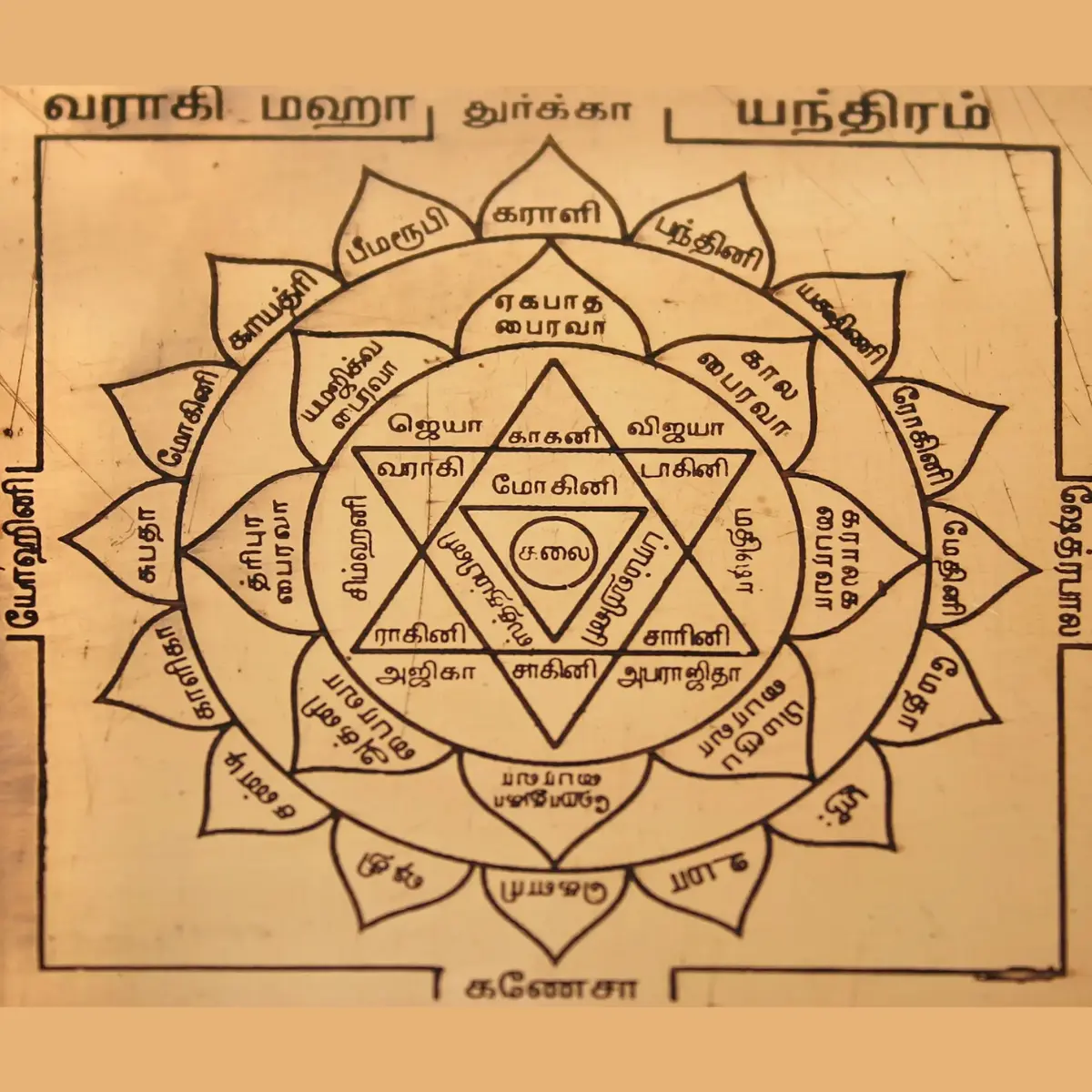
These mantras are not mere utterances; they are Bīja Mantras, seed syllables encoded with Varahi’s living presence. When practiced during rātri-kriyās (night-time tantric rituals) with a focused mind and purified intention, the yantra becomes awakened—transformed into a radiant field of spiritual armor and inner command.
Unlike yantras that are purely desire-fulfilling, the Varahi Yantra functions as a Yogic Seal of Command. It dispels psychic attacks, dissolves subconscious fear, and grants daivik śakti, a divine fortitude that empowers the sādhaka to move through both seen and unseen battles with calm sovereignty. Through repeated mantra-japa and meditative concentration upon the central bindu, the yantra becomes a living altar—a throne where Dandini herself silently resides: fierce, alert, protective, and unshakably compassionate.
This is not just a spiritual diagram, it is an astral yantra-sainyam, a sacred army encoded into form, a weapon of light offered into the hands of the sincere sādhaka walking the path of the Devi.
Varahi Yantra: The Transformative Shield of Astral Protection and Yogic Power
The Varahi Yantra (वराही यन्त्रः) is a sacred geometric embodiment of śakti that offers unparalleled protection and transformation to the sādhaka walking a path of inner mastery, courage, and transcendence. Its blessings are not limited to gross worldly gains but extend deep into the realms of the psychic, ancestral, karmic, and astral.
When worshipped under the guidance of a Sadguru and enlivened through disciplined mantra-anushṭhāna, the yantra acts as a shield against abhichāra (black magic), dṛṣṭi doṣa (evil eye), shāpa (curses), and afflictions caused by malefic planetary grahas, especially those of Rāhu and Śani. It fortifies the manas (mind), building unshakable resolve during intense sādhanās, and offers refuge to the sādhaka during phases of grief, despair, or existential disillusionment.
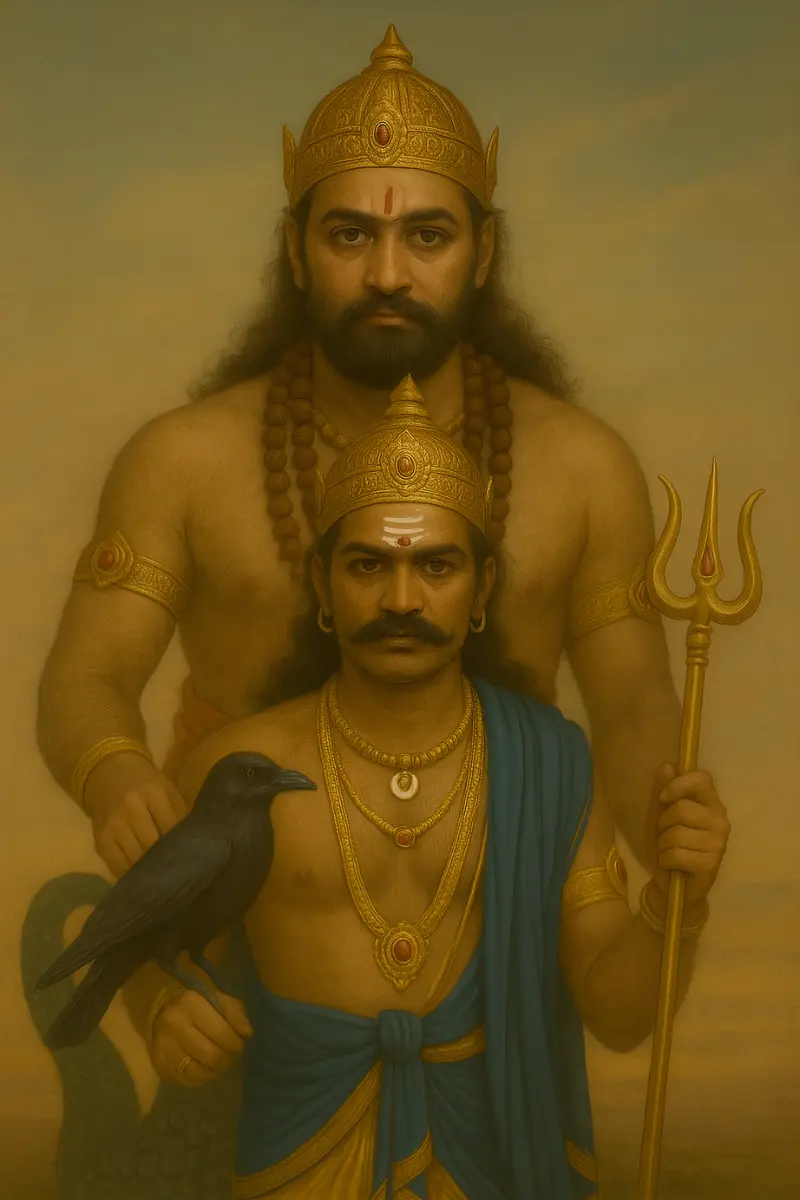
In the realm of external affairs, the Varahi Yantra has shown great potency in legal battles, land or property disputes, hidden enemies, political entanglements, and transitions involving loss, death, or trauma. As Śrī Varāhī is one of the few Devis who traverses śmaśāna-sthala (graveyard realms), she carries the power to navigate the soul through liminal spaces and unseen dangers.
For tantric sādhakas, the yantra assists in unlocking dormant energy channels within the nāḍī system and awakening latent siddhis (spiritual faculties) through sustained repetition of her bīja mantras. Women who approach Varahi with śraddhā receive not only physical and emotional strength but a grounding empowerment that stabilizes their śakti-tattva. For gṛhasthas (householders), the yantra becomes a silent guardian of the home, shielding the space from astral intrusions and subtle disharmony.
At deeper levels of use, the Varahi Yantra becomes a yogic anchor during night sādhanās, dreamwork, and astral travel. Her presence intensifies in the nocturnal hours, where she silently guides the sādhaka through inner terrains of power, shadow, and liberation—holding the light steady amidst darkness, and awakening the inner commander within.
Geometrical Significance of the Varahi Yantra: Vibration, Aura, and Subtle Transmission
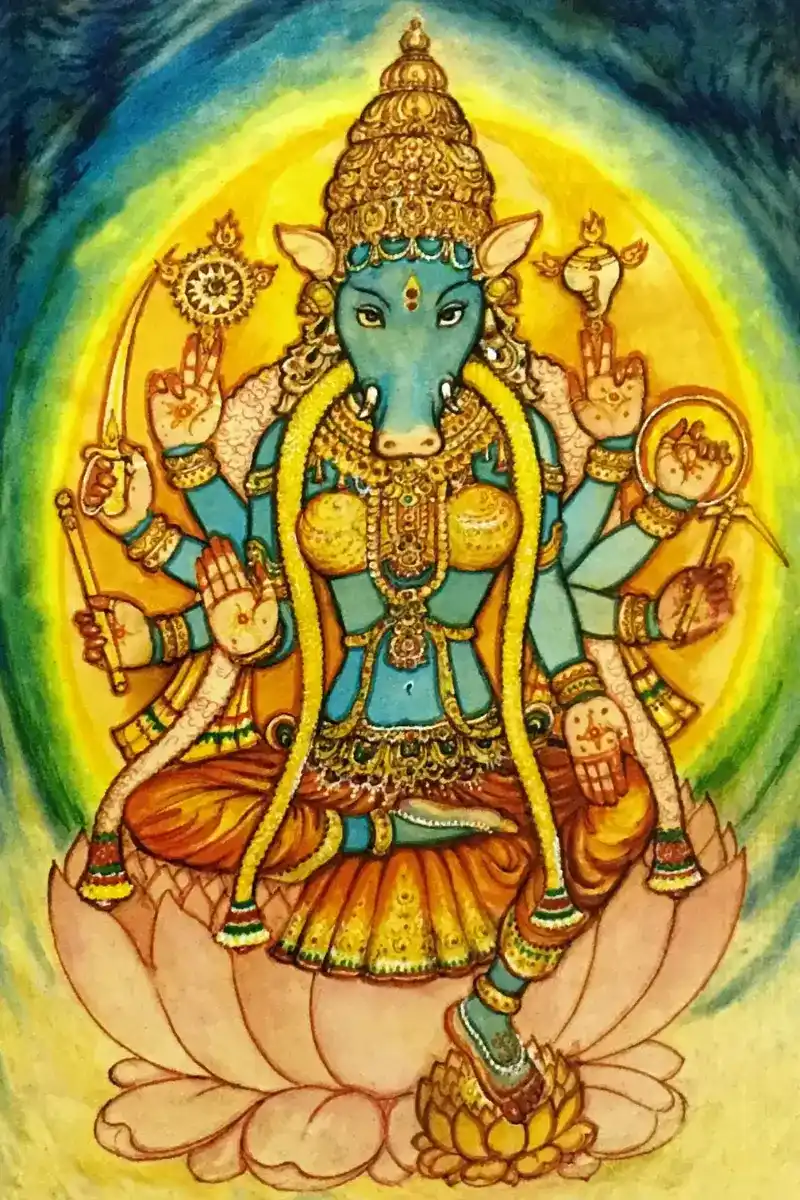
The Varahi Yantra (वराही यन्त्रः) is not an artistic symbol, it is a śakti-chihna, a living geometric frequency that pulses with mantra-infused prāṇa. Its lines and curves are encoded with mystic intention. Every triangle, lotus petal, and concentric circle within the yantra is an energy-conductor that responds to the vibrations of nāda (sound), creating a resonant field within the vāyumaya śarīra, the pranic sheath of the sādhaka.
The intersecting śakti-trikoṇas generate a śūla-karaṇa (vortexal force), silently drawing in the agitations of manas, such as fear, confusion, doubt, and transmuting them into viveka (clarity), śaurya (courage), and inner sovereignty. These triangles form subtle locks that regulate the inward descent of Devi’s icchā, kriyā, and jñāna śaktis (will, action, and wisdom energies) into the practitioner’s subtle body.
Encircling padma-valayas, the lotus garlands of eight and sixteen petals, not only stabilize the Anāhata (heart chakra) and Ājñā (command center) but also refine the bhāva (emotional atmosphere), cultivating spiritual detachment and fearlessness in worldly action. Their gentle symmetry harmonizes the aura-mandala, restoring the rhythm of the inner cosmos.
When installed within a dhyāna-sthāna or home altar, the yantra becomes a manasik kavaca, a psychic shield. Especially when placed in one’s bedroom or sādhana corner, it emits subtle currents that guard against astral disturbances, mental restlessness, and fragmented sleep. Its potency multiplies when one holds a focused dṛṣṭi (meditative gaze) upon its bindu while chanting Varahi’s bīja mantras with inner stillness.
During Gupta Navarātri, Rātri Kalpa Pūjās, and other nocturnal sādhanās, the yantra’s energy sheath becomes luminously active. Sensitive sādhakas may feel its radiance coursing through the suṣumnā nāḍī, creating gentle tremors along the spine and activating dormant seed points in the subtle body. In these moments, the yantra becomes a radiant setu, a bridge, between the manifest world and the loka of Śrī Varāhī, calling the soul back to its seat of original strength and silent command.
Mantras to Awaken the Varahi Yantra: Śabda-Brahma as the Key to the Deity’s Presence
The Varahi Yantra (वराही यन्त्रः) remains a silent geometric body until it is enlivened through śabda-brahma, the sacred sound current of her bīja mantras. These mantras are not random incantations; they are nāda-mudrās, vibrational keys that unlock the embedded śakti circuits within the yantra’s inner geometry. However, this process is not mechanical, it requires Guru-upadeśa and the subtle alignment of the seeker’s prāṇa with the mantra’s inner flame.
Among the most potent sonic frequencies that activate this yantra is the bija mantra “ॐ वं वराह्यै नमः,” which grounds the sādhaka into Varahi’s stabilizing force. This is complemented by the fierce protective strand “ॐ ग्लौं वराही दण्डिनी स्वाहा,” wherein the astral commander Dandini awakens as a guardian of the inner sanctum. The dynamic vibrational triad “ॐ ह्रीं ग्लौं ऐं नमः” unites wisdom (jñāna), protection (rakṣa), and creative force (icchā) into one stream of inner propulsion.
Central to all is the luminous Varahi Gāyatrī Mantra
“ॐ वराही च विद्महे दण्डिनी च धीमहि तन्नो धूम्रवर्णा प्रचोदयात्.”
This mantra is recited not for poetic devotion but as a precise tantric invocation to summon Varahi’s rahasya-rūpa (secret form), especially during rātri-kālika sādhanās, when the veils between dimensions are thin and her loka becomes accessible.
When these mantras are chanted with unwavering ekāgrata (focused intention) before an energized Varahi Yantra, preferably 108 times daily, the embedded śakti begins to stir. The yantra hums to life, radiating waves of protection, transformation, and silent command into the sādhaka’s aura.
Yet, one must remember: mere repetition without deekṣā is fruitless. Without the siddha-sankalpa of a realized Sat-guru, the yantra remains inert, a dormant map without the traveler’s key. Only through proper initiation (mantra deekṣā) and internal purification can the sādhaka enter the secret chamber of the yantra and receive the full anugraha of Śrī Varāhī. You may read our article on Kali Yantra to embrace the liberating energy that cuts through illusion and fear.
How the Varahi Yantra is Consecrated at yantrachants.com
At yantrachants.com, the preparation of each Varahi Yantra (वराही यन्त्रः) is not treated as a commercial process but as a devatā-prāṇa-pratiṣṭhā, a sacred birth of divine energy through mantra, kriya, and Guru-sankalpa. The yantra is not printed, duplicated, or industrially manufactured. It is individually handcrafted by initiated sādhakas, working under the guidance of a living Guru-paramparā, during nights of planetary potency.
The base of the yantra is Bhoja Patra, a rare birch bark revered in tantric traditions for its subtle ability to retain mantra-vibrations and prāṇic encoding. The ink is a sacred created with turmeric, Kesar, Kum Kum, Ashtagandha, and other sacred herbs. It is all energized under on Kṛṣṇa Pakṣa, Amāvasyā, or Mangalvāra, when Sri Varahi’s graha-dravya is most responsive.
Before the yantra is even touched, a solemn saṅkalpa is taken on behalf of the recipient, invoking Varahi to descend into the form through mantra and intent. A full Ṣoḍaśopacāra Pūjā is performed, focusing on the Dhooma Varahi mantras to call her rahasya rūpa into presence. The entire drawing is done using a mayūra-piccha (peacock feather) or śākhā-khaṇḍa (twig stylus), never synthetic pens, so that no foreign vibration interferes with the sacred encoding.
Once the yantra is complete, Bīja Nyāsa is performed over it, placing each mantra syllable into the corresponding petal, triangle, and bindu, like divine light sealed into form. Through prāṇa-pratiṣṭhā, the yantra is infused with jīva-bhāva.
Only after this sacred process is complete is the yantra sent to the seeker, accompanied by clear upāsanā-niyamas, basic ritual guidelines to maintain its sanctity. When received with śraddhā and followed with discipline, the Varahi Yantra becomes not just a sacred object, but a śakti-dvāra, a living portal through which the sādhaka may connect with the silent, commanding presence of Śrī Varāhī herself.
Adya Stotram and its Vaishnava Connections
Now, I shall state the benefits of reciting the Adya Stotram. There is a Vaishnava and Shakta perspective to this stotram. As per the stotram, the reciter develops love for Lord Vishnu.
How? Well, Devi is the sister of Sriman Narayana. Hence She is called Narayani or Padmanabha Swamy Sahodari. The two deities share a very close bond. As a fond brother, Lord Vishnu likes it when we glorify Devi.

So even Vaishnavas can recite the stotram.
How Shaktas See The Adya Stotram
Now, Let us look at the Shakta angle. Since Adya ma is feminine energy, she cares for her devotees. With her motherly veil, she protects us from the scorching heat of Samsara. She is sensitive towards the distress of womankind.
Childless women attain motherhood by Her grace. Devi prevents miscarriages and birth of stillborn babies when the mother recites the Kavacham with immense bhakti. The stotram particularly glorifies the fearsome form of Kali.
Sri Ramakrishna and Devi Kali
She has an affinity with the Bengali Saint Ramakrishna Paramahamsa who considers Her as his eternal Mother.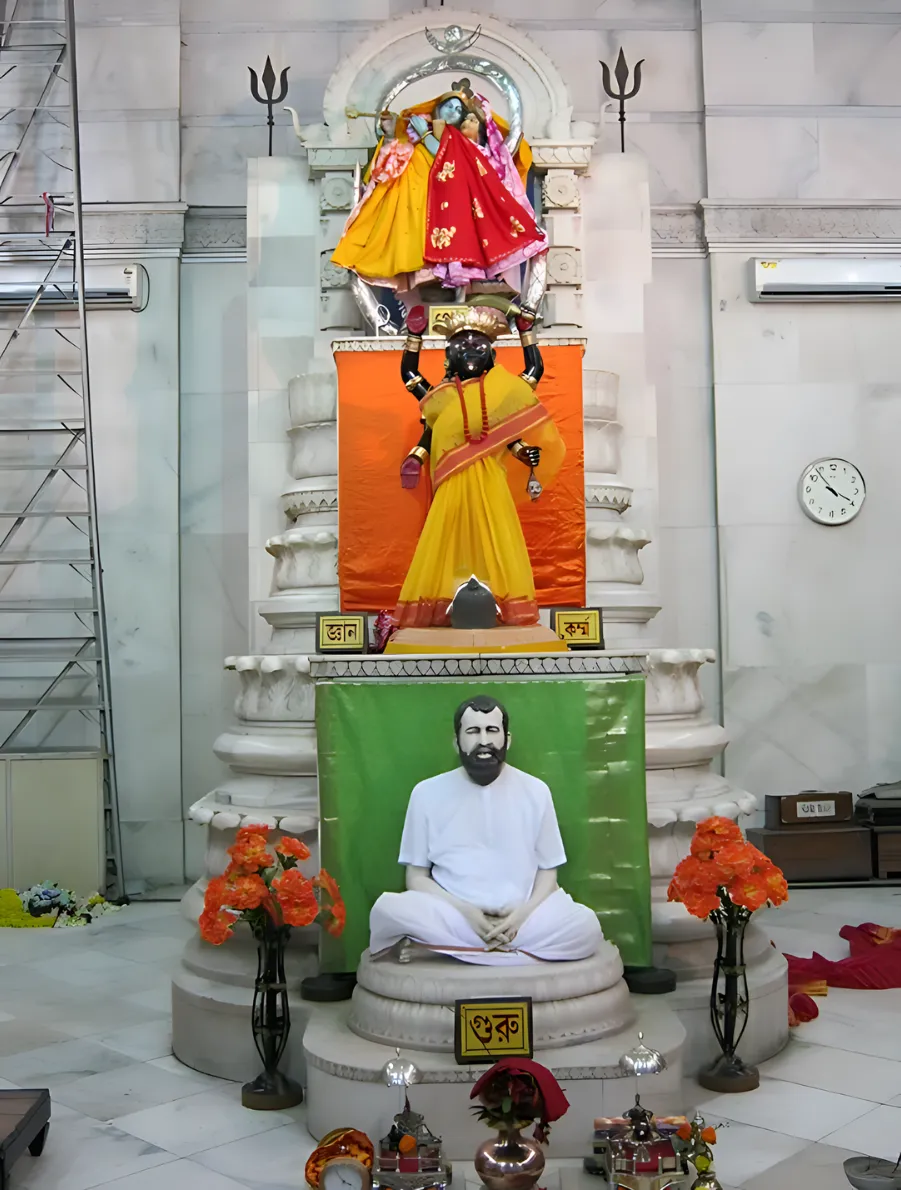
In West Bengal, the main altar of the Adya temple has three sub-altars. The lowest tier houses the idol of Sri Ramkrishna, the middle has Ma Adya and the top altar displays Radha and Krishna.
Benefits Of Chanting The Adya Stotram
Since Goddess Kali governs the dark energies of the universe, she offers protection from sickness, fever, death, enemies, and fear. The stotram too mentions the same. The goddess provides relief from sea or traveling-sickness.
Journeys end smoothly.
Listening to this esoteric hymn every day from the mouth of a pure devotee ends all bondages and attachments. Victory is a guaranteed feature that comes with this stotram, be it in war, sports, debates or competitions.
Write Adya stotram on a piece of paper and stick it on the temple wall of the house. There shall be no fear of fire or theft in the household. The wealth of the house stays safe.

It multiplies by the grace of Devi. The gods rejoice, when Devi is happy. They are the servitors of the Mother Goddess, By her instructions, they fill our lives with abundance.
For instance, when we face money problems, Lord Kubera shall support our financial needs. Thus we win the favor of all the gods. Devatas live in our bodies representing health, wealth and happiness.
So stay assured, that the recitation of the Adya Stotram promises all the three resources in one go. During bad times the engulfing energy of Devi shall suck out all heaviness and misery.

The goddess pulls the reciter in her suction like energy. One loses awareness of Kala, Time.
Hence, Kali is a Tamasik goddess, as her energy situates one in oblivion. The sadhaka may have a 6-Dimensional experience of Goddess Kali which might be frightful or intimidating.
Remember, The Stotram is Part of the Agama Tantra
Since the stotram is a part of an ancient agama tantra, it has cosmic vibrations encoded in every syllable.
So having an adept but desireless Tantrika Guru from a recognized tradition is mandatory, if one intends to take up the sadhana of this Stotram as described in the Agamas.
It works on our subtle bodies, changing our mental make-up. Adya Stotram is equivalent to Durga Kavach, but can be very heavy on our consciousness as compared to the Durga Kavach.
It may also result in short time mental distortions because of attunement to the various energies of the great Goddess of Time Sri Adya. It invokes Devi to protect specific regions of the body.

Thus in very little time we can complete the recital, along with Phalashruti. Also, the stotram invokes the various forms of Devi and the holy sites they live in.
Some include Katyayani of Vraja, Mahamaya of Dwarka, Kalika of Bengal and Maheshwari of Ayodhya.
Basic Rules for Chanting The Adya Stotram
One must observe a strict vegetarian diet with the exclusion of onion-garlic. Also, refrain from consuming alcohol and abusive substances. While invoking the divine mother, one must observe celibacy in thought, word and deed.
These lifestyle changes draw Devi’s attention at the earliest.
Who Can Recite The Adya Stotram?
I have many people asking me if they can chant Kali and Bhairav mantras without initiation. However, the question is- Can one handle the Shakti of Mahakali or Bhairava?
In Sanatana Dharma, every deity has an energy frequency. Let me give you an example.
A tiger and cow differ in their temperament. A tiger is ferocious while a cow is gentle. Hence, the way of approaching each of them is different. Only a well-built man of Rajasik temperament can approach a tiger else he may injure himself.

This is not the tiger’s fault. It is the way the tiger is. Similarly, Goddess Kali is raw Tamasik energy which needs channeling by a powerful and self attained Shakta Guru. The Sadhaka must handle her energy with care and caution.
Vishnu Mantras are Sattvik and safe to chant, symbolizing a cow. Trouble ensues all the more when one performs Tantrik Sadhana without supervision. Still, those who want to invoke Goddess Kali, should seek initiation and guidance from a qualified Shakta Guru.
Some seekers mistakenly associate Adya Stotram with solar hymns such as the Aditya Strota. While both invoke divine energy, their purposes are entirely distinct. The aditya strota praises the Surya (Sun God) and is a sattvik call to clarity and health, while the adya strotram is a tamasic fire, an invocation of the Great Time Goddess who dissolves fear, ego, and bondage. Understanding this difference is crucial for choosing the correct spiritual path.
If one does not have a spiritual master, one should pray for one. This is my personal take on taking up sadhana of the Adya Stotram.
Call upon Mother Varahi for deep protection and intuitive strength. Reserve your yantra now for personal activation.

